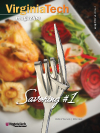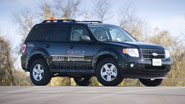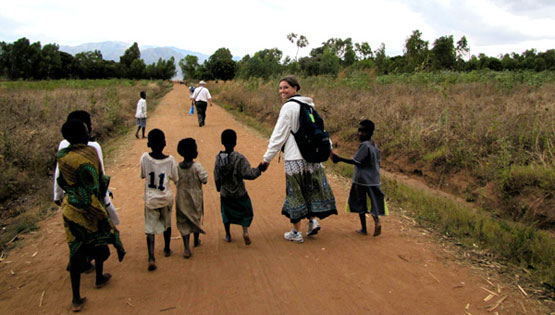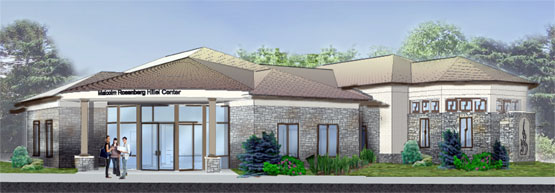 |
|
||||||
|
|
||||||||||||||||||||||||||||||||||||||||||||||||||||||||||||||||||||||||||||||||||||||||||||||||||||||||||||||||||||||||||||||||||||||||||||||
|
Blind driver makes history at Daytona by STEVEN MACKAY
As part of the ongoing Blind Driver Challenge, a blind man drove a 2010 Ford Escape Hybrid SUV on the famed course during the three-day Rolex 24 race extravaganza. At a top speed of 27 mph, he steered through obstacles that included stationary barrels and cardboard boxes thrown randomly from the back of a van. He then passed the moving van. Assisting the driver was high-tech hardware developed by Hokies. The driver—Mark Riccobono, an executive with the National Federation of the Blind (NFB)—navigated the course perfectly, capping years of research by teams of College of Engineering students led by Dennis Hong, director of Virginia Tech's Robotics and Mechanisms Laboratory (RoMeLa) and associate professor of mechanical engineering. "As Mark arrived safely at the finish line, hugging his wife with tears in his eyes, I couldn't help but also cry," Hong said. "I asked Mark if he could give me a ride back to my hotel. He is blind, but I knew he could see the big smile on my face." In 2004, the NFB, a nonprofit advocacy group based in Baltimore, put forth the Blind Driver Challenge: Create non-visual interface technology that one day could allow a blind person to drive an automobile. Virginia Tech was the only university and research institution to answer the call. Work began in 2006, and within three years, undergraduate engineering students had built a prototype buggy, which debuted at the NFB's Youth Slam summer camp in July 2009. The debut made international news, but this success was merely the beginning. From there, work began on second-generation Blind Driver vehicles, highway-ready cars that could conceivably be used on the open road. To meet the goal, Virginia Tech enlisted the help of TORC Technologies, a company founded by College of Engineering alumni and based at the university's Corporate Research Center. TORC had an essential ingredient: ByWire XGV technology, which provides reliable and safe electronic control of the vehicle and remote braking, among other modifications. Engineering students designed the non-visual interface devices used to operate the vehicle. The hardware includes wire-enhanced vibrating gloves called DriveGrips and a vibrating seat cushion called SpeedStrip. Both interfaces vibrate cues that indicate directions to accelerate, halt, or turn. The vehicles can "see" obstacles and the road ahead using strategically placed laser-range finders and cameras.
The next day, Jan. 29, Riccobono drove the track. "People asked me what [I was] going to say, and I had some things in mind," Riccobono said afterward. "But for me the moment spoke for itself. There were no words that would fit." Advocates at NFB acknowledge that the technology likely will be ready before insurers, highway regulators, and everyday motorists are open to the concept. Even so, the devices used in the SUVs—as well as other technologies developed by students during the Blind Driver Challenge—likely have other applications for the blind outside of driving, such as in home appliances, computers, and other everyday objects. In addition, the laser-range finders and technologies on the SUVs could be adapted to all vehicles. Consider the benefits of a laser-based collision warning alarm on a fog-covered mountain road."Humans do not adapt easily to what they think is impossible unless, of course, you are brought up to embrace technology, as some of us in the blind community have been," said Chelsea Cook (physics '14), who is blind and has driven one of the Blind Driver vehicles. "The ability to control a vehicle independently is amazing, but I'm just as curious to see the spin-offs and applications in other fields until society is ready for us to hit the road." Steven Mackay is the communications coordinator for the College of Engineering. |
|
|||||||||||||||||||||||||||||||||||||||||||||||||||||||||||||||||||||||||||||||||||||||||||||||||||||||||||||||||||||||||||||||||||||||||||||
| - - - - - - - - - - - - - - - - - - - - | ||||||||||||||||||||||||||||||||||||||||||||||||||||||||||||||||||||||||||||||||||||||||||||||||||||||||||||||||||||||||||||||||||||||||||||||
|
Warm hearts: Ventures to Malawi enlighten all
by JEAN ELLIOTT Malawi is not your typical study-abroad location, and the experience is sure to leave deep impressions. Led on an annual summer trip by Professor Patricia Kelly in the School of Education, Virginia Tech students teach in the Malawi schools for one month. Despite advance preparation with readings and discussions on hunger and poverty, nothing compares to meeting the children of this southern African nation on their own turf. Chants of "azungu, azungu" (white people) filled the air as streams of children raced out to greet the bus of summer 2010 visitors. Most children wore worn-out versions of a school uniform. Some wore shoes. Many crowded in and mugged for photos. In the crammed classrooms, more than 100 children sat side-by-side on concrete floors. There were no desks in the lower primary classes; tattered textbooks were shared. One child died of measles during the monthlong visit, while malaria sidelined teachers and children alike. Younger children who speak the native language of Chichewe must be able to pass national tests in English by standard [grade] eight or they cannot continue with school. The Virginia Tech students, who were majoring in human development, psychology, or education, concentrated on language skills, but also taught classes in health, math, social studies, and science.Daunting? Definitely. Rewarding? Absolutely. Known as the "Warm Heart of Africa," Malawi has deservingly earned a reputation for its compassionate population.
Tech students encountered faces of poverty and hunger, yet they also discovered a culture with a genuine zest for music, dancing, and community. "We quickly learned that the younger children focused by engaging in song," said FitzGerald. "In Africa, they do not waste time getting all the kids to focus." "They sing a song to bring the kids in. Singing is contagious, and once the teacher and a few kids from the front start singing, the kids in the back start singing, and pretty soon the whole class is focused on the teacher. It was an amazingly simple yet effective technique." "No other experience has taught me more than this trip," said Lauren Scheid (psychology '11). "I now think about how each of us is born into culture and how these cultures form our everyday lives. This experience has molded me into a better person, not because of what I did for them, but what their culture, the relationships I formed, and their genuine happiness did for me." On the weekends, the group traveled to various destinations, learning about sustainable gardening, local history, and culture. The group also visited Liwonde National Park for a wildlife safari and climbed Mount Mulanje, a majestic and fabled peak in the Old Rift. "Although I've been to Malawi more than two dozen times, each summer when I see the country and its people through the eyes of my students, everything becomes new and fresh for me," said Kelly. "No matter how much we give, we receive so much more through a heightened worldview and an increased appreciation of what we have." Jean Elliott is the communications manager for the College of Liberal Arts and Human Sciences. by Hillary May '12
Why brave the weather? Candles aren't allowed indoors on campus, so no other option was available. That will change soon. Virginia Tech's Jewish students—estimated to be about 4 percent of the student population—are awaiting the completion of the Malcolm Rosenberg Hillel Center for Jewish Life.
In memory of her late husband, Diane Rosenberg recently donated a challenge gift of $1 million to Hillel for the new building. Though neither of the Rosenbergs attended the university, they wanted to do something about the needs of the Jewish community at Tech, encouraging the students to "dream large." The center will be located on Toms Creek Road, right across from campus, and will offer a much-needed space. Stephanie Mahoney (interior design '14), a transfer student from a school where the Jewish community was not as engaged as Tech's, said Hillel helped her get involved and feel welcome in Blacksburg.Aberman, a freshman, agreed: "Especially for me, coming to a school where you only knew one or two people, Hillel is a great way to make friends and [attend services] and know you have something in common." Mahoney thinks that the new building will draw more Jewish students to Tech. "Having a building shows that the Jewish community is taken seriously," she said. "It also will give Jewish students a permanent place to go." Hillel's new center is exciting news for Sigma Alpha Epsilon Pi sorority and Alpha Epsilon Pi fraternity, Jewish-interest organizations on campus. Both groups have members on Hillel's executive board and make a strong showing at events. Andy Greisinger (finance '12), the president of Alpha Epsilon Pi, stressed the connection between Hillel and Jewish-interest Greek organizations. "We helped at the groundbreaking for the new Hillel building. [We] always show a great attendance at Shabbat and Hillel events," he said. Sue Kurtz, executive director of Hillel at Virginia Tech, emphasized how much this new center will mean to the organization. "It will be a welcoming place for everyone, and a place [that] will give the students an opportunity to be together in celebration of their culture and customs," she said. "It will give Hillel a focal point." Hillel anticipates moving into the new center in spring 2012.
• Return to Around the Drillfield |
||||||||||||||||||||||||||||||||||||||||||||||||||||||||||||||||||||||||||||||||||||||||||||||||||||||||||||||||||||||||||||||||||||||||||||||








